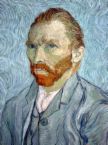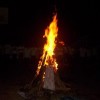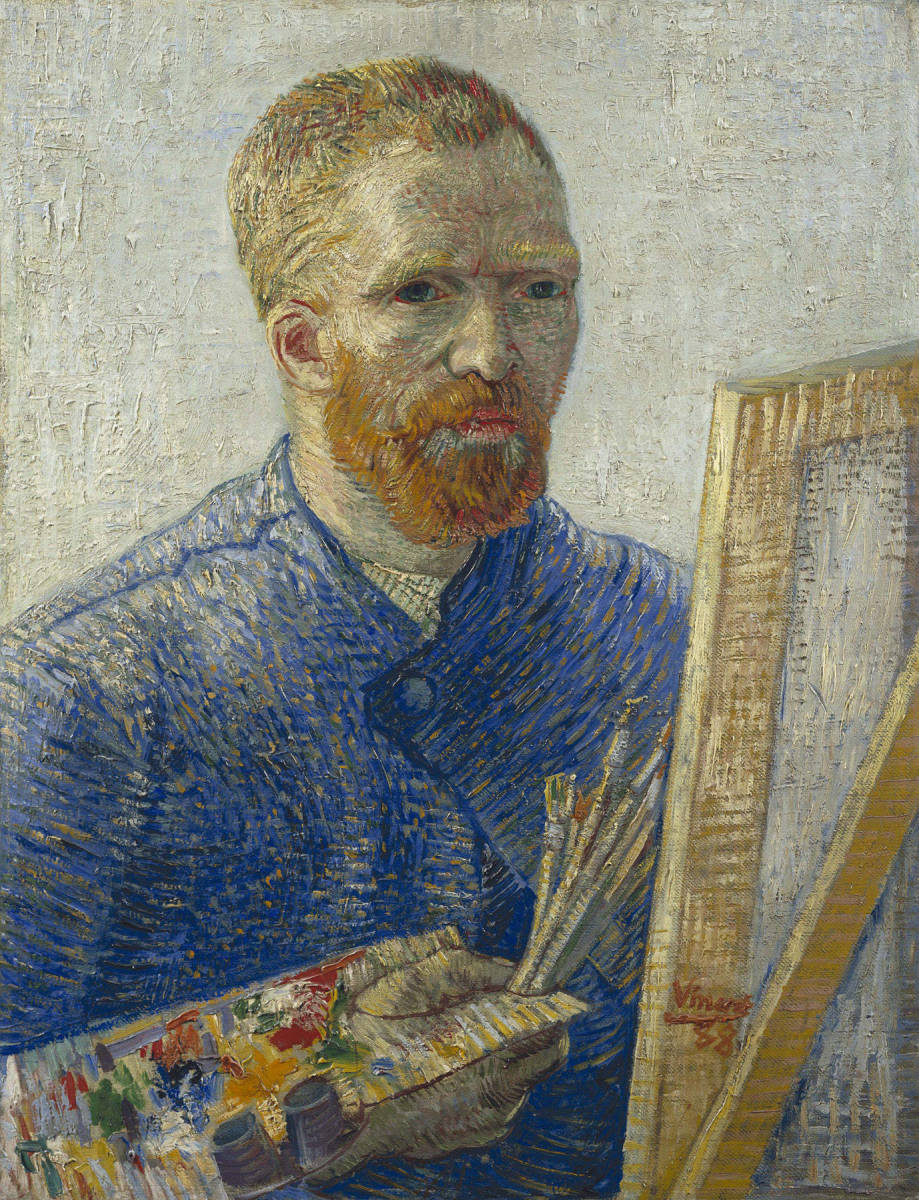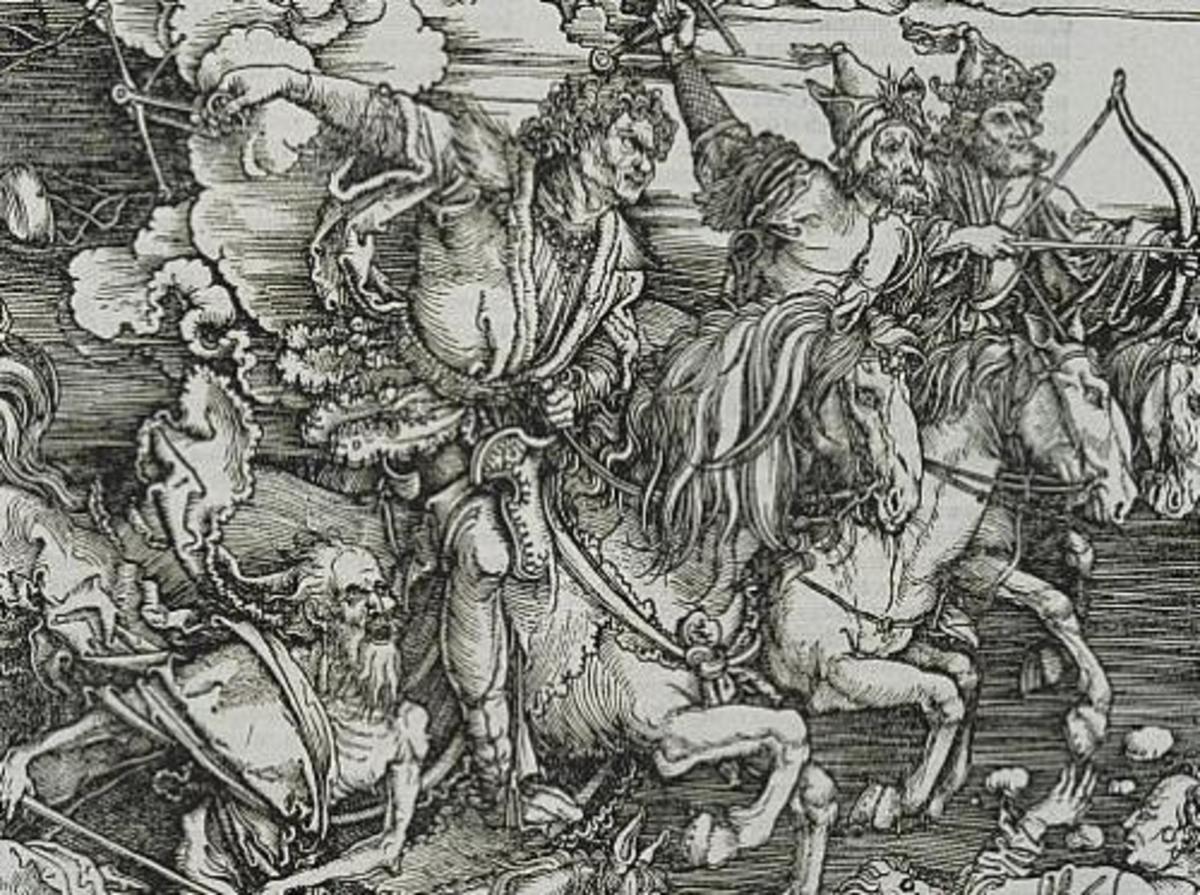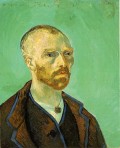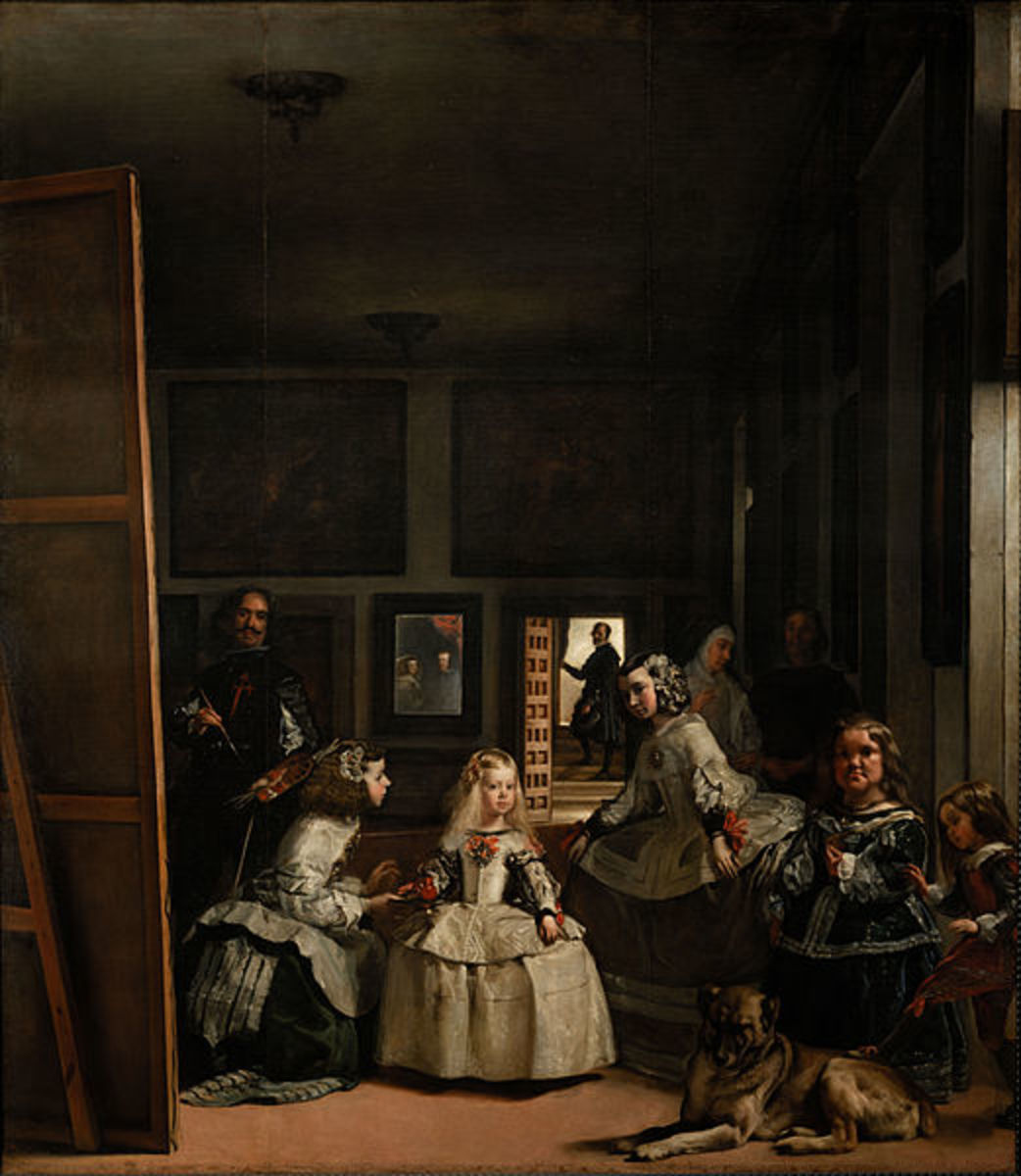Vincent Van Gogh
Vincent Van Gogh (1853-1890)
Vincent Van Gogh was the oldest son of a Protestant minister. He was born in Groot Zuudert in Dutch province of North Brabant on March 30, 1853. In 1869, after he had finished his studies at a boarding school in Zevenbergen, he found employment in the Hague branch of the art dealer Goupil. His brother Theo, with whom he maintained a regular correspondence that can be characterized as a kind of continuous examination of the artist's conscience, joined the Brussels branch of the Goupil firm in 1873, the same year that Vincent was transferred to the firm's London branch, where he proved himself as exemplary employee. In London, he fell in love with his landlady's daughter, Ursula Loyer, to whom he proposed and was mockingly rejected. The values of his Protestant bourgeois background was shaken for the first time. He sought consolation in the Bible. His parents perceived his deep. melancholy in Holland where he vacationed as a form of emotional disturbance and his employer subsequently sent him to Paris to recover his mental balance. He, however, suddenly returned to London to see Ursula Loyer once more.
In 1875, Goupil transferred him to London, where he visited museums and exhibitions while continuing reading the Bible in his free time. Meanwhile, he neglected his employment, proved impatient and irritable with clients and quarreled with his superiors. Consequently, he was dismissed, and he returned to his parents. In the spring of 1876, he accepted a post as a teacher of languages at a boarding school in Ramsgate, England. There and in Isleworth, a town to which the school was moved, was a sight of dismal poverty of the working people. The revelation of social misery, plus his reading of the Bible and his mystical bend caused a reorientation in his attitude towards society. That summer, he entered the service of a Methodist pastor and was entrusted as a preacher in a community of poor working people. Though he exalted poverty above joy in his sermons, he lacked eloquence and consequently, suffered another defeat.
At the beginning of 1877, he accepted a position in a bookstore in Dordrecht but was haunted by his religious callings. Obsessed by the example of his father, he decided to prepare himself a theological career and went to Amsterdam to take Greek and Latin courses required for admission in the theology department. This effort exceeded his piety, and, disillusioned by the differences he felt between the teachings of the Bible and the practice of Christianity, he had to give up. He did not renounce his vocation; however, with his father's help and with the goal of preaching to the poor mine workers, he attended in the school of practical evangelizing in Brussels. At the end of 1878, he left for the Borinage District where he settled in the village of Patu-rages near Mons. There, he taught the Holy Scriptures, cared for the sick, and instructed the children. At the beginning of 1879, he was appointed to preach in Wasmes. His zeal, further kindled, led to complete solidarity with the miners, so that he shared what he owned with his fellows, took their side in the strikes and tended those stricken by typhoid fever. But his devotion to the miners' cause scandalized his church superiors and his mission was discontinued.
His first drawing seems to date from this period. Two of them were sold to a pastor in Brussels, who sent Van Gogh on a mission in Cuesmes in the Borinage district. He stayed there for the winter of 1879-80, living in the most abject poverty and prey to gnawing moral torments since he despaired of his religious vocation. His correspondence with his brother halted for months while Van Gogh wandered through the Borinage and ventured on foot for as far as Courrieres (Pas-de Calais), the residence of Jules Adolphe Breton, a painter he admired and would like to visit. But lacking courage and discouraged by Breton's splendored studio, he turned back. This unfulfilled visit to the painter Breton might be the first sign of reorientation of his course toward the vocation of painting, though his aims remained obstinately the same, to share with his neighbors and to communicate to his fellows his passion, his pity, and his need for truth and consolation.
In the fall of 1880, after months of anguish and solitude, Vincent left for Brussels, determined to embark on a career in painting and eager to renew his ties with painting and painter. He accepted the advice of the Dutch painter Willem Roelofs (1822-97) and became a close friend of the painter Alexander (Anthon), Rider van Rappard, with whom he corresponded for the next five years. In Brussels, he took lessons in anatomy and perspective. It seems characteristic that among his drawings of this period there are copies of works by Jean Francois Millet (q.v.), the painter of laborers and the poor (e.g., The Sower, Amsterdam, Stedelijk Mus.).
In the spring of 1881, he returned to the home of his parents, who now lived in Etten, and started to work with enthusiasm. But during the year he suffered a new disappointment in love when he was rejected by his cousin Kee Strieker. As a result, he left Etten and moved to The Hague, where he sketched farm laborers and peasants in a style that aspired to expressiveness but still revealed a lack of animation and movement. There, he also advised or received advice from his uncle, the painter Anton Mauve, but he was soon irritated by his uninspired and routine teachings. His dispute with Mauve was aggravated by the fact that the latter reproached him for having taken in a pregnant prostitute known as Sien. During 1882, he lived with Sien and her child in his studio at Schenkweg 138, leading the life of a working man and feeling proud of this lowering of his social position, which alienated him from his friends and family. He spent a month in the hospital at the same time as the painter George Hendrik Breitner (1857-1923), who accompanied him on his tours through the city in search for subjects among the common people. During this productive period, he experimented with various techniques; applied lithography as a means of distributing his sketches to the people; executed charcoal and pencil drawings (e.g., Sad Old Man, Head of a Woman with White Cap, State Lottery; All, Amsterdam, Stedelijk Mus) as well as water colors, and painted his first landscape (e.g., Scheveningen Beac, Amsterdam, Stedelijk Mus.). He also read agreat deal (Emile Zola, Jules Michelet, Victor Hugo, and others) and acquired a collection of works by popular English engravers. This episode came to an end when his brother Theo convinced him that his stubborn endeavor to reform Sien morally was destined to failure.
Van Gogh left The Hague and took refuge in the lonely picturesque province of Drenthe, in the northern Holland, where he was enchanted by the vast horizon and the somber color. Examples of his work there are the paintings of Huts and Two Women Working on the Land. After three months, he left Drenthe and returned to his family in Nuenen, a small village northeast of Eindhoven, where his father has been appointed pastor. He adopted himself to family life, devotedly caring for his mother, who had a broken leg, and he continued his reading. Difficulties presented itself as a result of a love affair with a neighbor, Margot Begemann, and tension with the villagers who had been forbidden to pose for him by the parish priest. Nevertheless, it was at Nuenen that Van Gogh took the decisive steps in his formation as a painter; he painted and drew the peasants (Head of a Peasant), made studies with the weavers and their workroom (The Weavers) and painted the cemetery, the church (The Garden of the Parish Church) and the thatched huts. His efforts as a painter of peasants were crowned by his first masterpiece, The Potato Eaters for which he made two sketches. This painting, executed in somber but intense colors, represents the peak of his first period, which came to an end after his father's death in March, 1885, when Vincent left Nuenen for Antwerp. There, he entered the Academy and at first accepted docilely the discipline imposed by his professors, though this soon began to tell on his nerves. The crucial discovery of this sojourn was the work of Rubens, which revealed to Van Gogh the laws governing the principles of color that he himself had approached in his endeavors at Nuenen. It was also in Antwerp that he first became familiar with Japanese prints. The works he executed in Antwerp include two self-portraits (1885) as well as the Back Side of Old Houses and the Old Man with the Head of Victor Hugo.
In March, 1886, he rejoined his brother Theo in Paris where afjrer a warm reunion, the two brothers shared their life for almost two years. On his arrival in Paris, he enrolled in the atelier of Freehand Cormon, and through his brother he met and made friends with Toulouse-Lautrec, Emile Bernard, Louis Anquetin and Armand Guillaumin. The years in Paris yielded Van Gogh a series of discoveries: impressionism, the impasto technique of Adolphe Monticelli (1842-86) and further knowledge of Japanese prints.
Although the daily testimony of letters are lacking in this period, the works themselves testify to an essential change in Van Gogh's art. His palette became brighter with the use of light, pure colors, and owing to his contact with the impressionist, he adopted the pointillist technique (e.g., The Woman of Cafeaux Tambourins). This trait is especially notable in his self-portraits and in his series of still lifes, including Still Life with Flowers, Roses Tremieres, Shoes with Laces, Basket with Corusses and Apples. The importance of Van Gogh's Parisian period lies particularly in his assimilation of the most progressive currents in the paintings of the times. In those years, he absorbed the impressionist vision and technique and enriched his art with a new range of colors without losing his initial propensity for humble subjects.
In February, 1888, he left Paris for Aries, in the South of France. With the coming of spring, the sunny country reminded him of his native Holland, as evidenced by his paintings (the Drawbridge). In May, owing to Theo's generosity, he was able to rent a small house in Place Lamartine, which he planned to furnish and occupy with fellow painters. During this period, he became aware of the fact that, for him, the lessons of the impressionist had been only a transitional phase and that he was about to turn once more to the masters he had previously admired, Delacroix and Millet. In June, he first saw the Mediterranean when he passed a week at Saintes-Maries-de-la Mer, where he painted his most harmonious and balanced canvases: A View of La Crau and Fishing Boats in the Beach of Saintes-Maries-de-la-Mer. He was in very high spirits and applied his new manners in portraits, such as those of his friends. In September, he settled into the yellow house on Place Lamartine, which he immortalized in his painting The Small House of Vincent at Aries. For the bedroom intended for Paul Gauguin, he began to paint a series of sunflowers, of which his best composition is now on Tate Gallery. Inspired by Delacroix theory of color, he set out in search of the autonomous and symbolic values of colors.
Gauguin arrived in Aries towards the end of October, and during the two months, they were to share the yellow house, the two painters fired each other's genius. However, daily contact and working together caused mounting tension between these two extremely different temperaments; Van, a religious enthusiast, and Gauguin, a critical creator. At Christmas, the crisis exploded, and Van Gogh cut off his earlobe after a quarrel with Gauguin, who consequently fled from Aries. Van Gogh was taken in at the hospital and Theo came to visit him. in February, after Vincent returned to his house, he was overtaken by a second crisis and was hospitalized again. In March, on the basis of 80 townspeople's petition, he was once more placed in a hospital. In the interval of seizure, he painted the versions of La Berceuse, the portrait of Dr. Rey, his doctor. In the hospital, he received the news of his Brother's marriage on April 17; at the same time, he expressed the wish to be admitted to the Asylum of Saint Paul-de-Mausole at St. Remy. On May 9, he left Aries and entered the asylum. On his arrival there, Van Gogh began to paint again, first in the garden of the hospital and then on the surrounding countryside. In his landscape, such as A Road With Cypress and Cornfields at Sunset, there is a marked change in his technique and color. His brush described dynamic curves, and stronger tones issued from his palette. In the summer and again in December, he was overtaken by crises, during which he could not leave his room. Thus confined, he made a black and white copy of works by Delacroix, Millet, Honore Daimier, and Gustave Dore, rendering highly personalized variations on the themes provided by the masters he most admired (e.g., The Good Samaritan, Pieta, Sheaving Girl, and Sower, etc.)
In January, 1890, he received news of the birth of his brother Theo's son who was named Vincent.
In March, one of his paintings, The Red Orchard, the only one to be sold in the open market during his lifetime, was bought in Brussels.
On May 17, 1890, Van Gogh arrived in Paris for an extraordinary three-day visit with his brother and sister-in-law. From Paris, he went to Auvers-sur-Oise, where he entrusted himself in the care of Dr. Gachet, a patron and a friend of painters. Working with great zest, Van Gogh painted portraits of Dr. Gachet and his daughter as well as peasants and landscapes. Theo and his child came to visit him one day in June, and the artist spent Sunday, July 1, in Paris where he visited his friends. On his return to Auvers, he became despondent for having his brother's generosity. He painted some large convases in which he tried to express extreme solitude and melancholy. On July 27, 1890, he shot himself and died two days later, aged 37, with Theo at his bedside. Six months later Theo died and they are buried in the cemetery at Auvers-sur -Oise.
Though Van Gogh had devoted only nine years of his brief intense life to his art, he left almost 600 paintings and more than 800 known drawings and water colors. Through impressionism, he advanced from the traditional, almost provincial Dutch paintings of the beginning of his career to horizons unknown to his time. He created fresh domains for painting and paved the way for a school for painters that has not yet attained the summits reached by him. He had a clear sense of mission, which he did not succeed in satisfying. Like many of the artists in the 19th century, Van Gogh was impelled in his work by an inspiration that was fed by his experiences with poverty and social injustice (London) and by his commiseration with fellow men (miners at the Borinage).
His letters to his brother Theo constitute a passionate testimony of his life and stand as a literary monument of far reaching importance. He declared that "the love of man is something one might suppose exists in every human being as the foundation of almost everything." With this exemplary modesty, he practiced this love of mankind in his daily work. To Van Rappard, he wrote "Let your light shine for men - I think that is the beauty and duty of every painter. In my opinion, it does not follow, however, that this light should be spread through exhibitions. I must tell you that I hope for more and better opportunities to take art to the people than those given by exhibitions."
It was, above all, this comprehension of painting that revolutionized the world of art. Van Gogh gave painting new purposes, a true mission which he himself pursued with evangelical zeal. In an epoch that aspired for the perfect, isolated work he could write: "It is, therefore, agreeable to work for people who do not even know what a picture is." "It is true that common people who treat themselves to color prints and enjoy the sentimental music of the hand organs are somewhat more in the right and perhaps more sincere than certain men-about-town who frequent the Salon." To his brother, he explained the mission he sought to fulfill by painting: "In my life and in my painting, I can very well do without God, but wretched as I am, I cannot do something that is greater than myself, something that is my life: the power to create. And if one is frustrated physically and seeks to create ideas instead of children, he thus becomes a part of humanity everywhere. And in piaure, I should like to say something as consoling as music. I should like to paint men and women with that suggestion of the eternal which used to be symbolized by the halo, and which we seek to achieve by the radiance and the vibration of color itself."
